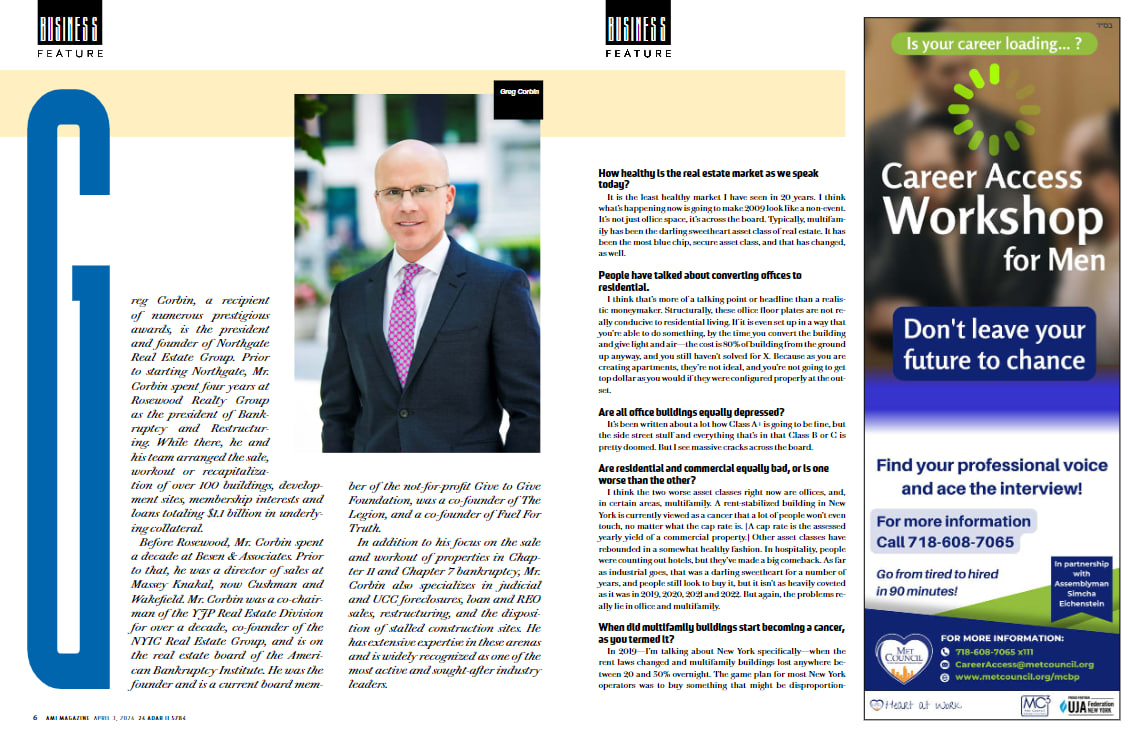How healthy is the real estate market as we speak today?
It is the least healthy market I have seen in 20 years. I think what’s happening now is going to make 2009 look like a non-event. It’s not just office space, it’s across the board. Typically, multifamily has been the darling sweetheart asset class of real estate. It has been the most blue chip, secure asset class, and that has changed, as well.
People have talked about converting offices to residential.
I think that’s more of a talking point or headline than a realistic moneymaker. Structurally, these office floor plates are not really conducive to residential living. If it is even set up in a way that
you’re able to do something, by the time you convert the building and give light and air—the cost is 80% of building from the ground up anyway, and you still haven’t solved for X. Because as you are creating apartments, they’re not ideal, and you’re not going to get top dollar as you would if they were configured properly at the outset.
Are all office buildings equally depressed?
It’s been written about a lot how Class A+ is going to be fine, but the side street stuff and everything that’s in that Class B or C is pretty doomed. But I see massive cracks across the board.
Are residential and commercial equally bad, or is one worse than the other?
I think the two worse asset classes right now are offices, and, in certain areas, multifamily. A rent-stabilized building in New York is currently viewed as a cancer that a lot of people won’t even touch, no matter what the cap rate is. [A cap rate is the assessed yearly yield of a commercial property.] Other asset classes have rebounded in a somewhat healthy fashion. In hospitality, people were counting out hotels, but they’ve made a big comeback. As far as industrial goes, that was a darling sweetheart for a number of years, and people still look to buy it, but it isn’t as heavily coveted as it was in 2019, 2020, 2021 and 2022. But again, the problems really lie in office and multifamily.
When did multifamily buildings start becoming a cancer, as you termed it?
In 2019—I’m talking about New York specifically—when the rent laws changed and multifamily buildings lost anywhere between 20 and 30% overnight. The game plan for most New York operators was to buy something that might be disproportionately expensive on day one, even if it was negative leverage on the cap rate they were getting. In 2015 you could sell a three cap even if people were borrowing at a higher rate because they knew they could turn a $1,400 a month apartment into a $6,000 a month apartment, multiplied out to 12 months and multiplied by a gross rent multiple of 20, or at least high teens. If you carry the one that’s well worth buying these buildings, because within a year or two, you’d be able to become very profitable. And as you bought tenants out or they left through natural attrition, you would be able to profit. That was the business model in New York for a very long time, which was being used to make money on these rent stabilized buildings.
Once they had essentially stabilized those units for perpetuity and there are a lot of nuances to the rent laws, which would take 20 minutes to explain in and of itself—the upshot was that you can’t destabilize units anymore. If your expenses are going up faster than your income, and the rent guidelines board either freezes rent or allows them to only be increased by one or two percent, there is no incentive for owners to do any work in the buildings. They’re not getting any of the rent increases or vacancy increases, or they’re not able to spread out the cost of any capital improvements or MCIs or IAIs, so a lot of these buildings are starting to fall apart…
People fail to realize that people went from having a very good net worth to hovering around break even just because of the new rent laws. I just had this conversation a few weeks ago with a very left-wing liberal who was wondering why their greedy landlord was raising their rent so much. They were saying that it was just unfair. I said to them, “Unfair? How about someone who had $100 million in real estate and went down to having $70 million in real estate overnight.” Before I could finish my point, they said, “Oh. Poor baby. Boohoo. Seventy million.” I said, “Well, you and many others in New York don’t understand how real estate works, which is that you have $30 million in equity, and you borrow $70 million from the bank. So when that $30 million gets eroded, you have zero dollars and might have to file for bankruptcy because everything else was debt to the bank. You’re not going from very rich to just rich, you’re going from very rich
to break even or the loss of everything you’ve worked to build over decades.”The average person doesn’t quite understand how devastating these rent laws were to property owners.
Then put COVID in after that. The main part of COVID, aside from people not paying during that time, was that they learned the lesson, especially in these rent stabilized buildings, that if they don’t pay, there are really no repercussions. The recourse is that the property owner has to take them to Housing Court, which often costs more in attorney fees than their portion of the Section 8 rent. So collections on a lot of these rent-stabilized buildings went from 90-something percent to 70-something percent. Again, on a percentage base that might not sound like much, but when you’re talking about the net operating income, it has a huge impact. Then interest rates went from near three percent to near seven percent, which created the perfect storm of taking profitable buildings with a solid business model and bringing the vast majority of them underwater. All of these things have been bubbling over the years and getting worse and worse.Typically we were working on about five deals at any given time for the last 15-18 years, but right now we have 26 bankruptcy and foreclosure deals that we’re working on, and every few days we get a new phone call from someone who is being foreclosed on and has to figure out either a workout or restructuring with their lender, whether it’s a private hard money lender or an institutional or regional bank, or it might already be transferred to servicing. They might need to do a workout or restructuring in the form of a discounted payoff or new interest rates with a paydown up front, or they might just have a forced sale.Part of what you just discussed is strictly a New York problem. To what extent is this also a national issue?
It’s a national issue along the lines of COVID decreasing rent payments, which I believe is permanent, and interest rates jumping so high in such a short amount of time. Again, we had people who were borrowing at sub three percent going up to seven percent, which nationally leads to people not being able to refinance or having to do a cash-in refinance. That means that there are thousands of buildings that are underwater. In a lot of these instances the lender would typically foreclose, but now they don’t want the building back. Normally, they would be ecstatic to get the keys without having to go through a prolonged foreclosure period, but now both the borrower and the lender are telling each other, “You can have it.”So it’s definitely nationwide, but in New York specifically, the rent stabilization exacerbates the COVID and interest rates issues. New York is probably worse than I’ve ever seen. And again, multifamily properties that are rent stabilized has gone from blue chip to the least desirable asset class.As we discussed, many landlords had been looking to convert from commercial to residential. Why would they still be tempted to do that in such a soft residential market?
If you have an office property or some sort of larger industrial property and are not able to make the numbers work, the grass seems greener on the residential side. And if you’ve read the headlines, it seems that the residential market is white hot, rentals are getting more than they’ve ever gotten, there’s very little supply along with a huge demand—especially since interest rates are higher, which makes it more challenging to purchase an apartment. People hear all of that and want to jump into that side of the business. But if you speak to many of the operators, it’s a lot more challenging to execute than it looks, and things take way longer and much more money than they would ever expect when doing the math on paper.
You made the comparison before to 2009, when the banks really suffered because of all the foreclosures. Should we expect to see that in the near future?
In 2009, it was a financial meltdown, and the issue was isolated to the lenders, which affected the borrowers, and there was a lot less activity and far fewer transactions. And the banks were not lending and were being a lot more cautious. The Fed managed to bail out a lot of these banks, and the overused cliché of kicking the can down the road was apropos. And that’s what happened.
They were bailed out, and they didn’t let the toxic assets really flush out of the system. There were far fewer opportunities for distressed assets than people had expected, and there were not too many way-below-market trades or people buying notes. The market got healthy relatively quickly, the banks were able to hold onto most of their properties, and because of the artificially low interest rate environment, a lot of people were able to right the ships. By 2011 and the years to follow, it was just a steady value climb, so the distress didn’t flush through the system. This time around, because of the three issues that I previously mentioned, it’s a whole different ballgame. This is a lot of asset level problems with no solution. In 2009 that bailed itself out because interest rates were so low and remained that way, and again, it was sort of isolated to that financial problem. This time around, there’s a conflux of all of these different factors, and there are
tens of thousands of buildings that are at least 20-30% below the value of the debt alone.
Are banks still lending or have they stopped?
They’re still lending. They’re just being more cautious with their pro formas, because when everything in the market is going up, the rising tide buoys all ships, so even if you were not so conscientious when underwriting these deals, and even if you did fudge a little bit, there were very few issues, and people weren’t getting into trouble for writing bad loans because the market just
kept rising. Once the market starts to fall, people pull out the magnifying glass and question why these loans were written.
During the heyday, a bunch of the banks, like Signature and New York Community Bank, and a lot of these multifamily lenders would take pro formas into account. Before the rent stabilization laws when everything changed, if someone gave the bank a pro forma showing the amount of turnover they would be able to achieve in a year and what the rents could be, the bank didn’t loan solely based on that, but it did take it into account. Now, it’s very different, and the banks are becoming a lot more conservative.
The debt service coverage ratio (DSCR) has gone up and banks are making fewer loans, but the real change is that refinancing activity has dropped drastically. Again, because so many of these buildings are underwater, you can’t refinance them. The only way to do it is with a cash-in refi, and a lot of that five-year, seven-year, ten-year money—a lot of these loans are maturing, and
there’s no way you can make a building work at a much higher cap rate with much higher interest rates. That was a huge source of income, and not only for the banks and mortgage brokers. But it’s not tenable to do that anymore.
The interest rates are supposedly going to be heading downward soon. Will that revive the market? And are lenders taking that into consideration by being willing to lock in loans now at higher interest rates?
I think that whatever they’re going to do with interest rates is already somewhat priced into the market. Between the spring of 2022 and 2024, where we are now, the Fed hiked interest rates ten or 11 times, so lowering it two or three times, and only at a quarter or half a point… We don’t know what’s going to happen anyway. Most of the time the Fed follows through with what they indicate they’re going to do, but again, even if they drop it three times at half a point, it’s still considerably higher—almost double—of what it was at the low. It’s a case of too little, too late. Even if they reduce as planned, it’s not enough to get these buildings to be profitable and cover debt service.
You mentioned New York’s Housing Court. Appearing as a landlord in New York’s Housing Court is almost like being a Jew in a prewar German court. Most judges view every landlord as a bad guy who is taking advantage of their tenants, which is a major problem.
In Housing Court and a lot of liberal New York and America, the landlords are guilty until proven innocent. As I mentioned from that one conversation, people think that these landlords are fat, greedy individuals who are there to prey upon their tenants and take advantage of them. Whereas the reality is that they’re businessmen who live in a, for now, capitalistic society and country, where if the market is a certain amount for rent and can sustain certain prices, it’s not tzedakah that they’re going to give away apartments for cheaper than other people are willing to pay. It’s not a chesed to let people live there for under market. There are even certain people in government right now, such as Julia Salazar, who has said publicly that if people call her a communist or a socialist, it’s true. Her philosophy is that real estate “belongs to the people and shouldn’t be privatized.” She feels that people shouldn’t be able to profit off of other people. Unfortunately, people like her don’t see it as a business, and a lot of people, especially in New York, view it the same way. And a lot of the judges and constituents are very left leaning and anti-landlord. They just don’t like to see wealthy people.
When a person faces the problems you outlined before and can’t meet his debt service because his property is not producing enough income, and the property is not worth the value of the debt, where do they go from there?
In the past, most of our job mainly consisted of pure brokerage. We would be approached by either the borrower, the lender or an attorney to sell the property and actualize whatever the outcome of the sale would be. Hopefully, we would be able to have conversations with the lender prior to the sale. One of the main concerns of any borrower, especially if they’re going to file for bankruptcy, is that they trigger a personal guarantee or recourse, whereas the bank is then able to sue and come after them for deficiency judgment, which is the delta between what the property sells for and the amount they owe. If they owe the bank $10 million and the property sells for $8 million, the bank then has the claim for the $2 million, and sometimes they’ll go after the borrower for the difference.
Whereas our business was almost always to sell, now we’re coming in often as advisers and consultants to negotiate between borrower and lender and hopefully come to some middle ground that both parties can live with. These days, the lenders want a paydown, they don’t just want to give the borrower a lower rate or a discounted payoff just because they can’t make their debt service.
They want to see more skin in the game, and they’d like the borrower to put money in from day one at whatever percent they negotiate. After that, they’re willing to talk to them and potentially give them a forbearance to push the foreclosure down the road.
What are the solutions?
One of the solutions we’ve been coming up with is what’s called a consensual prepack, or prepackaged bankruptcy, where the lender agrees not to pursue the guarantor on the personal guarantee or the recourse, and they will file it together. If we’re representing the borrower, our reporting would typically be to the borrower of how many inspections we did and showing them everything prior to going live with any of our offering memorandums, banner ads and advertisements. We would share the results of everything with both the borrower and the lender, and the lender is involved in the day-to-day process of how many inspections, how many offers, what’s transpiring on the marketing process, and again, it’s a horse trade for forgiving whatever the shortfall is and not pursuing the deficiency judgment.
One of the benefits of this type of bankruptcy is that it saves the transfer tax, which is a considerable amount of money—approximately three percent, which is a lot in a larger deal. A lot of times you can save the mortgage recording tax if the mortgage is going to be assigned. It also wipes out any of the unsecured creditors, so any of the liens and incumbrances that were placed on the
property are all wiped out. And when a lender signs onto something like this, it’s because it’s going to be a very controlled and much faster process. We’ll agree to do 90-100 days, and the borrower will sign off on whatever the outcome is, versus a borrower who is able to stay in bankruptcy for a year to a year and a half if they have a chief restructuring officer or a good attorney who is able
to maneuver. The time/use value of money for the lender is much better served to be done in a few months versus a year and a few months or even longer.
We’re trying to do the negotiations with lenders, we’re doing these consensual prepack bankruptcies, and that’s what we’re very busy with these days with new borrowers coming in quite frequently.
Lenders are also pursuing a remedy along the lines of what’s called a UCC foreclosure, which is an article 9.
Non-judicial foreclosures.
Correct. For a senior secured lender—a traditional bank—their loan is collateralized by the property itself. In New York, these foreclosures often take between two and five years when it’s a judicial foreclosure. In a UCC foreclosure, often the mezzanine lender makes the borrower sign off. Or even if there’s a pledge in the loan docs with the senior secured on what’s called the membership interests of the company or LLC, they are essentially selling—they can do a UCC auction. It used to take 30 days, but now it’s 60 days to be conservative after COVID. It forces the borrower’s hand to either pay them off, file that Chapter 11 instead of potentially waiting a few more years during the foreclosure process, or, more often than not, the lender ends up credit bidding and are
able to get the path back to get the deed, because they’re essentially stepping into the borrower’s shoes and becoming their own lender. Because after the UCC process, they take over the LLC or the borrowing entity— it’s essentially the membership interest in the company that borrowed—and they’re able to do that very quickly, even in New York.
Restructuring through filing Chapter 11 sounds very good, but it can also be very complex. While in bankruptcy court, you give up your rights, and you almost feel like you’re a prisoner to a certain extent to the whim of the court and the judge, who can do things that may work against you. It’s not a very pleasant or predictable experience. Would you agree with that?
Not so much. It actually transfers a lot more control back to the borrower. When it’s in foreclosure, the lender is driving the car, and often, even though it’s a very long process, it can creep up on the borrower, and things happen out of the borrower’s hands. For example, if the lender is able to appoint and put a receiver in place, they usually take over management of the building. When
the borrower files for bankruptcy, most times the receiver is kicked out of management position or powers, and control over the course of action is given back to the borrower to be able to select their team. They can pick a chief restructuring officer, they can pick a broker, they can pick an adviser, they can pick an attorney, and that transfers the control and really the pace of the bankruptcy back to the borrower.
If the borrower chooses to file Chapter 11 and then does nothing, after 120 days they lose their exclusivity on the plan of reorganization that they filed, and the lender will often come in and file their own plan or a competing plan, in which case the borrower might lose control. However, as long as the borrower can show the judge that they are taking the appropriate steps to pay off the lender or execute on this plan of reorganization to remedy the situation, the judge usually gives them leeway and enough time and extensions to get it done, as long as they can prove that they haven’t just filed a bad-faith bankruptcy to buy time and do nothing.
Yes, but the United States Trustee takes a thorough look at your books and records and does things like that, and you have to be very transparent. At times, if a person has done something that was detrimental to the health of the property, that may come back to bite them.
Right. A lot of the stuff that’s on paper, and you are correct about the United States Trustee. Everything starts with a 341 meeting, and there’s a lot that needs to be done when you file for bankruptcy. It’s not like you just check a box and are then off on your own. You have to open separate bank accounts and file a lot of paperwork, and as you said, there’s accountability for past documentation and rent collections. However, if you haven’t done anything that you aren’t proud of or that’s illegal, there isn’t much to worry about. It’s pretty infrequent— that I’ve seen at least—in bankruptcies that people have committed some sort of fraud or malfeasance. Short of that, it’s a good option for people who are about to lose their properties.
Also, when you sit with the United States Trustee and don’t say all of the truth and nothing but the truth, you can be prosecuted criminally for that, and I’ve seen people have that problem.
I think that’s a big anomaly, but again, people who have committed a major fraud are probably not going to file. If they were really challenged and do have some sort of reason, even if it isn’t an excuse… During COVID, which increased bankruptcy filings exponentially, if they weren’t getting paid by their tenants, they were hesitant to pay their lenders, not knowing where their next dollar was coming from. The product that we’re selling right now is stalled construction, because during COVID the banks weren’t funding the hurdles or certain milestones, so the borrowers were complaining, “How can I build and finish my building if the bank isn’t funding me?” And the bank was saying, “I’m not funding because you haven’t hit the hurdles that we agreed on to release the next batch of funds.” It’s not just the multifamily and offices; there’s a lot of stalled construction from COVID, and a lot of borrowers who are filing for bankruptcy. They didn’t set out to do anything wrong. They didn’t set out to take a loan and then miss their first payment or misappropriate funds. They were a product of real circumstance, of COVID and rising interest rates, and they aren’t afraid to show books and records if ordered by the judge. People have to show what’s been done, but a lot of people don’t have anything to hide. They were really just victims.
There are tax repercussions if a loan is forgiven, which can come back to bite the borrower with the IRS. I’m assuming that you deal with that when you advise clients.
Yes. We send them straight to a tax attorney. I don’t want to give any legal advice, but you are correct; it’s certainly an issue.
Let’s talk about opportunities. We’ve been speaking about a very bleak market. What you’re offering is the opportunity to resolve problems, which is the light at the end of the tunnel. But there are also opportunities at a time like this to seek properties that are distressed and are being foreclosed on and find a way to make money from them.
There are fewer opportunities than it would seem from the sidelines. Although there is a lot of distress in the market right now, it hasn’t worked its way through. Because both the borrowers and lenders are in a Mexican standoff, with neither making too many moves, we’ve had instances where we were working on a deal for a year and a half because the borrower stopped paying their mortgage in 2022, but it’s not an opportunity for a buyer yet, because it hasn’t even hit the market. It’s because people have been just closing their eyes and hoping for the best without addressing it, and because the foreclosure process takes so long in New York. Additionally, the banks are very hesitant to sell notes at a discount, because once they start selling them, it’s not
just price discovery anymore, it’s a real mark to market, and everyone thinks they’ll be able to get this type of discount. Also, a lot of the lenders don’t want to take that loss or actualize it on their books.
For private lenders, it’s a lot harder to raise money, because everyone wants to see your resume and track record. If you’re taking losses on stuff right now, it’s much harder to raise your next funds. So when they can, they’ll take the property back and try to add the value back themselves rather than dump it at a discount to market. Again, the floodgates have been held back for a very long time, and some of the properties and loans have started to dislodge themselves and present opportunities—if you have the right connections. A lot of them are being done on a much quieter basis; they aren’t being mass marketed.
As a broker, most of the time when people come to us and it’s in a federal bankruptcy, they need to be mass marketed. So even if we were able to find the person willing to pay the most money on our first phone call, the full process needs to be run, because at the end of the process we submit a very lengthy marketing report to the court to show all of mediums that we advertised in, the amount of emails we sent out, the amount of responses we received from investors, the amount of tours we conducted, the amount of offers we got, all of the different social media and websites we posted on, etc. They need a very thorough report to show that it was an armslength transaction and there were no improprieties. When a full process gets run like that and tens of thousands of people see the deal, there’s not that much of an opportunity to buy something at a discount.
And again, since the lenders are keeping things pretty close to their vests, there aren’t the discounts one would expect when they hear about the distress. I think that’s going to happen at the end of this year; there’s going to be a lot more opportunity. People have been waiting for that, and there’s a lot of cash on the sidelines. We get calls from people who are sitting on large amounts of
cash and haven’t yet found those opportunities. It’s a few quarters away, but when it happens, it’s going to happen in a big way.
Can you summarize what you’re offering potential clients?
Some of it is workouts and restructuring, when we’re able to negotiate something with the lender. If there’s a potential consensual process, we can work or renegotiate or restructure the loan or negotiate a reinstatement. Some of it is the sale process, where we will sell an asset for the highest price, and that’s why we’ve been very busy, thank G-d, bli ayin hara, because people see the prices that we are selling the assets for, and it’s mostly a referral business. Also if a borrower decides to sell the property on their own or they hire a broker, a lot of times the lender would say that the number they sold it for was below market or they sold it to a friend or didn’t have a good broker, so they will go after them for a deficiency judgment or won’t allow the sale to go through. Whereas if we’re brought into the picture, we know a good majority of the lenders. We’re hired by them and have good relationships with the private lenders, the hard money lenders, the banks, the special servicers, so once they see that we’ve run this full robust process, they’re a lot more likely to work with the borrower and let them off the guarantee or any deficiency judgment. They know that if we’ve run the process, we have turned over every stone, and whatever price we’re getting is already market plus.
Do you deal with the bankruptcy courts as well?
Yes. I’m in bankruptcy court and on Zooms and hearings frequently, probably more than any other adviser or broker who is working in New York right now. Again, we’re currently in the midst of working on 26 different bankruptcies and foreclosures.
Do you appear on behalf of the lender, the borrower, or is the court asking you to get involved? How do you get involved?
Three out of four times, the borrower is hiring us, and then the other 25% of the time it’s the lender who hires us to conduct either the UCC foreclosure or, if the borrower’s exclusivity runs out on their plan, the lender files their own plan, and they’ll hire us to sell it under their plan, or they’ll put a lot of pressure on the borrower to sign with us. One of the other value adds that we provide is that if something goes to a judicial foreclosure, you tend to get a lot of lowballers who try to pick things up for 50 cents on the dollar. The lenders will often pay us to market that property, even though we’re not conducting the auction, just so they can have another 20-30 people show up and make more aggressive bids than if it were just the people who typically show up for these auctions and try to buy them for cheap. If there’s an ad in a newspaper, you’re going to have the typical auction goers who are always there and figure they’ll make a lowball bid, and if they get it, they get it, if they don’t, they don’t. That’s not nearly as effective as us sending an email to 110,000 people, which covers the investment community, bankruptcy, turnaround and restructuring professionals who like to give these deals to their investment clients. We have attorneys on our list. We have high net worth individuals. We have lists of thousands of other brokers. Just by getting it out to that large of a database through those investors and word of mouth, we’re able to bring buyers to the steps in the judicial foreclosures as well.
I think that one of your strengths is that you know both the mentality of the borrower and the lender, so you can make that match between them.
That’s correct. If we’re working on behalf of one, we do know what’s in the mind of the counterparty, so we have a better roadmap that we can lay out to our client. Oftentimes we will be hired because people know that we have a relationship with the counterparty, so it’s not going to be adversarial, and the people will listen to our recommendation and advice. For example, if people see that we just sold a property for a lender, who relied on us for our opinion on the property value, and they trust us because they hired us to market and sell it—if they hired us, they’re assuming that we’re going to get the highest price for them. The borrower sees that and says, “Since they have a relationship with that lender, if I hire them, it will be less adversarial and more of a consensual process, and maybe they’ll be able to convince that lender that we’re not bad guys and are working with them, and if there is a shortfall on the sale, the lender will say in their minds, ‘This is really top dollar.’”
Reciprocally, the lenders will sometimes bring us on board and say, “We haven’t had any luck getting the borrower to the table. We’ve sent them ten emails, we’ve called them ten times, but they don’t get back to us. We know that you’ve worked with them before. Maybe you can bring them to the table and convince them that the best option is not to put their head in the sand and ignore the problem but to come to the table and negotiate an outcome that can work for everyone.” Either side will bring us on board know that we can be the neutral, moderating party.
Many attorneys say, “We only represent landlords,” or “We only represent tenants,” especially in housing court, but you wear both hats.
That’s a very astute observation. A lot of the lenders don’t have one go-to law firm. They’ll hire a lot of the big law firms so they can conflict out these attorneys who then say that they don’t work for borrowers and only work on the lender side because of conflict of interest.
How big is your operation?
I’ll tell you a little about our company. I started the bankruptcy and restructuring division at Rosewood in 2019. My team and I left Rosewood in June 2023 and started our own firm. We were doing more bankruptcy and foreclosure work as brokers and advisers than any of our competitors and anyone else in New York, but we were under the umbrella of an investment sales firm. We were in a position where we didn’t want to be the top team at an investment sales firm; we really wanted to brand ourselves as the top brokerages and advisory firm in the distressed asset space. We wanted to become, and we are, synonymous with bankruptcy, foreclosure, restructure and workouts. Often, when I go to event or even when I’m at a Shabbos dinner, people will say, “Oh, you’re the bankruptcy guy,” or “You’re the foreclosure guy.”
I’ve been doing a lot of speaking on panels because we’re sought after as the industry expert in those niches. Yesterday, I was on a panel on distressed real estate, and I’ll be speaking at the American Bankruptcy Institute Conference in Washington, DC, in a few weeks. I was in Miami a few weeks ago to speak at the IMN Bank Special Assets Conference. There’s an RE Deal panel event and conference that I’ll be speaking on as well. It’s the hot topic right now, and we are seen as the foremost, go-to industry experts in those niches. It’s a language in and of itself, and a lot of the lawyers who refer us business appreciate that they don’t have to explain it to us. They can ask us to run a Chapter 7 versus Chapter 11 liquidation analysis, whereas if they were to ask that of a more bread and butter investment sales broker who will have never done that before, they won’t even know what they’re about, while it’s commonplace for us. There’s a lot that’s involved in a bankruptcy sale versus a regular investment sale, and people don’t recognize or appreciate how much nuance and language there is to this niche that we play in. It’s a very small sandbox. There are the chief restructuring officers, the lawyers and the brokers.
I guess that people don’t want to introduce you at a dinner party: “I’m friends with Greg Corbin, who is my bankruptcy adviser.”
There’s less of a stigma now. In the past, there was more embarrassment or shame if someone needed to file for bankruptcy, but now it’s just used as a mechanism to get more leverage and a better outcome if someone is in trouble. There’s also a lot less stigma because of rent laws, COVID and interest rates. There are so many people who are in that boat—it’s the majority; it’s no longer an anomaly. There are very few rent-stabilized owners who are healthy right now.
So you don’t have to hide your face or cover it with a mask when you walk into bankruptcy court.
Correct.
How many people do you have on your team?
We are a team of eight. We’ll be moving office space in the next few weeks, at which point we’re going to start hiring. It’s a very good problem to have. Thank God, we are underwater with the amount of work we have; I’m putting in 18-hour days. We need to staff upto handle all of the business that we’re getting. The space we’re in right now was temporary when we left R osewood a nd s tarted our own company, and now we’ve taken on a new lease and will be moving in the next few weeks. We’ve gotten an astounding amount of resumes and people reaching out with phone calls. There was a big article in Real Deal about me starting my own firm when we left Rosewood, and we were inundated with resumes. But because we were so busy doing the deals, we didn’t have the time to conduct a lot of those interviews to get help. We were so busy with the deals and the emergencies that we couldn’t take a step backwards to be able to take two steps forward. But we are now looking to staff up, and people who are talented or have experience in this niche will be brought on board to handle all of the deals. So we expect to grow exponentially going forward.
Your growth means our shrinkage, if that’s a fair statement.
(Laughs) Yes.
I wish you a lot of growth, but I hope that a lot of people don’t suffer in the interim.
Yes. We like to do good and do well. Obviously our own livelihood and careers… We need to make money like the next guy, but we are helping a lot of people get themselves out of very problematic financial situations that are not only financial but can take over someone’s livelihood, mental health and their life. We’ve gotten a lot of people out of jams that they weren’t able to get themselves out of for quite some time prior to our arrival, engagement or retention. ●









